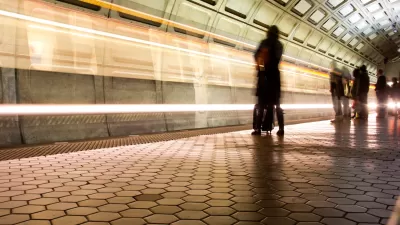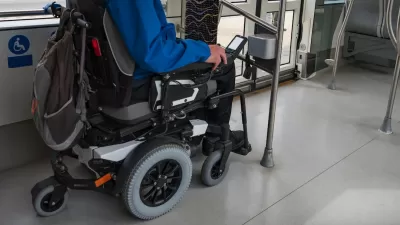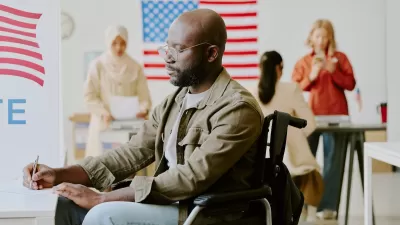The Americans with Disabilities Act was passed in 1990 to protect people with disabilities from discrimination, but more work is needed to make U.S. communities accessible to all. And planners have a key role to play.

The Americans with Disabilities Act was signed into law on this day (July 26) 34 years ago. Usually referred to by its acronym, ADA, this legislation was the first of its kind to prohibit discrimination against people with disabilities, similar to the anti-discrimination measures of the Civil Rights Act of 1964. Its importance in ensuring disabled people have equal opportunity to move around their communities and can access public and private services and locations cannot be overstated.
According to the U.S. Census Bureau, 42.5 million people (13 percent) in the United States have a disability, which the ADA defines as a physical or mental impairment that substantially limits one or more of a person’s major life activities. That means more than one in 10 people in your community have some kind of disability, many of which are not visible. The ADA defines disabilities as difficulties seeing, hearing, concentrating or remembering (i.e., neurological conditions, including Alzheimer’s, learning disabilities, autism, and ADHD), walking or climbing stairs, dressing or bathing, doing errands alone such as buying groceries or going to the doctor.
Accessibility and accommodations for people with disabilities are massively important for urban planners and other built environment professionals like architects and engineers, not just because they are legally obligated by the ADA but because it eliminates barriers and burdens and ensures people with disabilities can experience our communities in the same way as everyone else. It’s not a great community unless it’s great for everyone. Unfortunately, cities, towns, and villages across the U.S. still have a long way to go to be truly inclusive.
Below is a collection of 11 recent Planetizen stories detailing considerations and the importance of ADA-friendly practices in urban planning:
- Analyzing Accessibility Disparities: With better planning we can reduce disparities between drivers and non-drivers in their ability to access services and jobs, improving fairness and economic opportunities for disadvantaged groups
- Let's Get Some Things Straight: ADA in America: The Planning Commission Podcast: Exploring Universal Design
- How Cities Still Fail People With Disabilities: Even when accessibility is taken into account, transit stations and pedestrian infrastructure often still fail to make appropriate accommodations.
- America’s 15 Most Accessible Cities: These cities are the easiest to navigate for people in wheelchairs or with mobility challenges.
- How Car Dependency Impacts People With Disabilities: People who are physically unable to drive can benefit from effective public transit systems and accessible, mixed-use neighborhoods.
- Being a Non-Driver in a Car-Dependent World: A third or more of Americans cannot drive due to their age, ability, or other factors. How can their travel needs inform our transportation systems?
- How to Protect Pedestrians With Disabilities: Public agencies don’t track traffic deaths and injuries involving disabled people, leaving a gap in data to guide safety interventions.
- Understanding Accessibility in the Public Right-of-Way: A ‘best practices’ manual guides accessibility on streets and sidewalks, but remains legally unenforceable.
- How to Improve Transit Accessibility: Over 13 million Americans face mobility challenges that limit their travel experience.
- Making Trip Planning Easier for Vision-Impaired Transit Riders: The app provides navigation using audio and haptic cues to improve accessibility for people with low vision.
- When Bathroom Access Restricts Mobility: For parents of young children, people with mobility equipment, and others, a lack of accessible public restrooms can mean limited outings.

Trump Administration Could Effectively End Housing Voucher Program
Federal officials are eyeing major cuts to the Section 8 program that helps millions of low-income households pay rent.

Planetizen Federal Action Tracker
A weekly monitor of how Trump’s orders and actions are impacting planners and planning in America.

Canada vs. Kamala: Whose Liberal Housing Platform Comes Out on Top?
As Canada votes for a new Prime Minister, what can America learn from the leading liberal candidate of its neighbor to the north?

Washington State’s Parking Reform Law Could Unlock ‘Countless’ Acres for New Housing
A law that limits how much parking cities can require for residential amd commercial developments could lead to a construction boom.

Wildlife Rebounds After the Eaton Fire
Following the devastation of the Eaton Fire, the return of wildlife and the regrowth of native plants are offering powerful signs of resilience and renewal.

LA to Replace Inglewood Light Rail Project With Bus Shuttles
LA Metro says the change is in response to community engagement and that the new design will be ready before the 2028 Olympic Games.
Urban Design for Planners 1: Software Tools
This six-course series explores essential urban design concepts using open source software and equips planners with the tools they need to participate fully in the urban design process.
Planning for Universal Design
Learn the tools for implementing Universal Design in planning regulations.
Central Transportation Planning Staff/Boston Region MPO
Heyer Gruel & Associates PA
Institute for Housing and Urban Development Studies (IHS)
City of Grandview
Harvard GSD Executive Education
Regional Transportation Commission of Southern Nevada
Toledo-Lucas County Plan Commissions






























